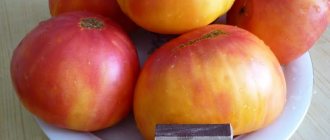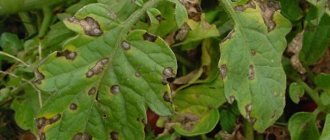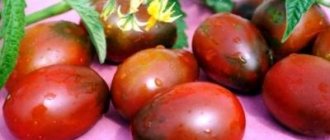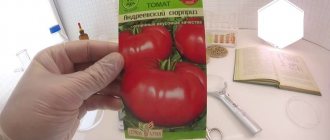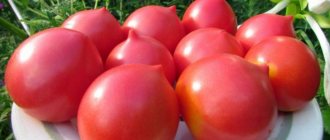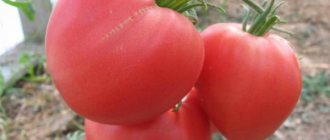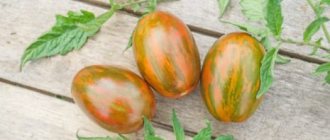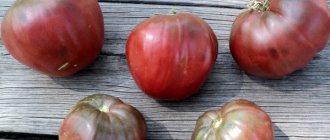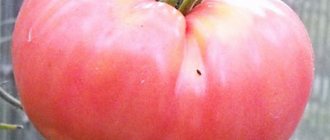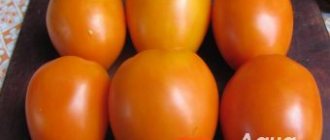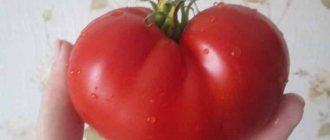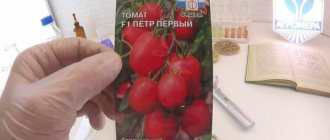History and description of the Dubrava tomato variety
I won’t be mistaken if I say that you can find tomato bushes in almost every garden. After all, a tomato from your garden is much more aromatic and tastier than store-bought. Therefore, breeders are happy to create varieties with improved characteristics for hardworking gardeners.
The Dubrava tomato was bred in the 90s in the Moscow region. Having passed the required variety tests, in 1997 it was enrolled in the State Register for the Central and Volga-Vyatka region. The variety is recommended for cultivation in open ground in household plots, garden plots and small farms.
The Dubrava variety can also be found under another name - Dubok. But this name can rather be attributed to the folk name.
Dubrava tomatoes - a promising domestic variety
Characteristics of the variety
Each variety has a certain set of qualities that help the gardener choose the plant he likes. The Dubrava tomato has more than decent characteristics.
- The variety is early ripening. On the 85th day after full germination, the fruits begin to ripen in regions with a warm climate; in cooler climates, the ripening period begins later - on the 105th day.
- Productivity is high, but depending on the region this indicator may vary. In the Central region - 133 - 349 c/ha, which is 24 - 106 c/ha higher than the standard varieties Alpatieva 905 A and Peremoga 165. In the Volga-Vyatka region, the yield is higher - 224 - 551 c/ha, which is almost one level with the Siberian early ripening and Peremoga 165 standards. The maximum yield level is shown in the Republic of Mari El - 551 c/ha, which is 12 c/ha higher than the Siberian early ripening standard.
- The fruits have a universal purpose. Tomatoes are suitable for fresh vitamin salads and pickling, as they do not lose their shape, and are used for preservation and processing into tomato products.
- Disease resistance is average. There is an average susceptibility to late blight of the vegetative mass.
- The variety is plastic. When the environment changes - drought or high humidity, the Dubrava tomato is able not only to develop, but also to form fruits.
- The variety does not require pinching, which makes it easier to care for.
- The fruits have good shelf life - if stored properly, they do not lose their presentation for almost 1.5 months. The variety can withstand transportation over long distances.
Dubrava tomatoes - video
Appearance
Dubrava tomatoes are determinate plants. This term is applied to low varieties. The Dubrava bush has a height of 40 to 60 cm. It is compact, weakly branched and has medium foliage. The leaves are ordinary, small in size, green, slightly corrugated. The first simple inflorescence is formed under the 6th - 7th leaf, and then flower clusters appear after 1 or 2 leaves. One cluster can bear up to 10 or more fruits.
The fruits are round in shape with a smooth surface. The weight of the fruit ranges from 53 to 110 g. During the period of technical ripeness, they are painted in a rich red color. The skin is strong. The pulp is dense and fleshy, but somewhat dry. There are from 3 to 6 seed nests. The taste of fresh fruits is assessed as satisfactory and good. The taste is dominated by light sourness.
Dubrava tomato fruits, due to their dense pulp, are ideal for pickling
Advantages and disadvantages of the Dubrava variety - table
| Advantages | Flaws |
| Compactness of the plant and absence of stepsons | The taste may be dominated by sourness |
| Early fruit ripening | Average resistance to late blight |
| High yield | Average resistance to late blight |
| Ability to withstand temperature fluctuations well | |
| Versatility of use | |
| Great looks | |
| Good shelf life and transportability |
A distinctive feature of Dubok tomatoes from other varieties is the absence of stepsons, which makes care very simple.
Advantages and disadvantages
The variety has a large number of positive aspects, which is why it has not lost popularity for 20 years. The advantages of the Dubrava tomato variety are recognized:
- cold-resistant;
- early fruiting;
- resistance to late blight and fruit production before a mass outbreak of the disease;
- stability of yield under any, even the most unfavorable, conditions;
- the possibility of including culture in landscape design due to the special decorative effect of the bush;
- minimal care for the plant, which does not require tying or pinching;
- high-quality setting and ripening of tomatoes, even in the worst weather with minimal lighting;
- possibility of growing in a small area;
- good transportability;
- drought tolerance;
- possibility of using tomatoes for salads and preparations.
There are practically no disadvantages to this variety of tomatoes. The only disadvantage of Dubrava can be called some sourness of the fruit, but this property is observed in all early-ripening and early-ripening tomatoes.
Features of planting and growing
Dubrava tomatoes are grown in two ways - seeds and seedlings. The seedling method can be used in any region suitable for cultivating the variety. But seed is used only in the southern regions.
The time for planting seedlings is determined depending on the region. In warm areas, seeds are sown from the beginning of March until the end of the month. In cool weather - in early April. The timing must be determined very strictly; the seedlings should not outgrow. Overgrown seedlings take root worse and later form a harvest. The main thing is that no more than 60 days pass before planting the seedlings in the ground.
Overgrown seedlings will begin to bear fruit later
The seedling method ensures early fruit ripening and higher yields. But the yield will directly depend on the quality of the seedlings. Despite the fact that Dubrava seeds have good germination rate - up to 95%, they need to be processed before sowing for seedlings.
- First, sort the seeds, removing the smallest or deformed ones.
- Then you need to check the quality of the planting material to separate the empty seeds. To do this, pour clean water into a small container and place the seeds in it. After some time, high-quality seeds will settle to the bottom, and empty ones will float to the surface.
- Disinfect the seeds by soaking them in a 1–2% solution of potassium permanganate for 15–20 minutes. 3% hydrogen peroxide is suitable for the same purpose (by the way, it also speeds up the germination process). The seeds need to be kept for only 20 minutes in a solution of 0.5 liters of water and 1 tbsp. l. peroxide.
Manganese solution disinfects seeds
Before sowing seeds, prepare the soil mixture and container. The soil should be nutritious and loose. A suitable composition can be purchased at a specialty store. But you can use soil from a garden bed. To make it more loose, add coarse sand. Before use, such soil must be disinfected by frying it in the oven or spilling it with a manganese solution.
Oblong plastic containers with drainage holes are used as planting containers. Before filling the box with soil mixture, place a layer of drainage on the bottom. Moisten the soil thoroughly before planting.
You can purchase a convenient container for growing seedlings.
The seed depth is 1.5–2 cm. To make planting easier, you can use a wooden ruler to press the grooves and place the seeds in them. The distance between seeds is 2.5 - 3 cm, the width between rows is up to 5 cm.
Furrows for sowing seeds can be easily made using a wooden ruler
Conditions for seed germination and seedling care
- After sowing, the container with the seeds is covered with a plastic bag and placed in a warm place. Germination requires a temperature of 18 – 25°C. The shelter needs periodic ventilation, and if necessary, the soil is moistened with a spray bottle.
- In less than a week, shoots will appear. After this, the container is moved to a well-lit place for 5–7 days. But the temperature is reduced to 15°C during the day and 10 – 12°C at night. This will prevent the seedlings from being pulled out.
- When a week has passed, the seedlings are again placed in a warm place. The night temperature is not lower than 16°C, and the daytime temperature, depending on the weather, is not lower than 18°C on cloudy days, but not higher than 24°C on a sunny day.
- Water Dubrava tomato seedlings only with warm water, at the root. It is important not to overwater the seedlings or keep them in dry soil. Adjust the frequency of watering depending on the temperature. On sunny days the soil will dry out faster, so moisten more often. The fact that there is not enough moisture will be indicated by the leaves that begin to droop.
Dubrava tomato seedlings are watered at the root with warm water
- To prevent the seedlings from stretching, turn the container with different sides towards the window every day. For normal development, seedlings need at least 12 hours of full lighting. If it is not enough, you need to additionally illuminate the plants with phytolamps or fluorescent lamps.
If the seedlings do not have enough light, use fluorescent lamps
- Fertilizer is applied twice. The first time when the first pair of true leaves appeared on the seedlings. The second - a few days before planting in the ground. Complex mineral fertilizers for seedlings are used as fertilizing, preparing the solution according to the instructions.
Picking
Picking is necessary, because seeds are germinated in shallow containers, and the root system does not have the opportunity for normal development. Therefore, when the seedlings have 2 - 3 true leaves, you need to pick them into a separate container.
Picking will help the seedling grow powerful roots, which will then help the plant quickly take root in the garden and provide itself with nutrition. But it should be remembered that after the procedure the seedlings will stop growing for some time.
For seedlings of low-growing varieties, such as Dubrava, you can choose not very large pots - 8/8 cm in size. Before the procedure, no later than 3 hours, the seedlings are well watered. Then the seedlings are buried in the soil before the cotyledons begin to grow. To avoid the formation of voids, water the soil with warm water or a very weak solution of manganese. The seedlings are kept in a shaded place for 2–3 days.
Picking tomatoes - video
For a week after picking, the temperature is maintained at 20–22°C, then lowered to 15–18°C. During the first 2 weeks, transplanted tomatoes especially need moisture, then the frequency of watering should be reduced, allowing the top layer of soil to dry slightly.
1.5 - 2 weeks before planting in open ground, seedlings begin to harden. You need to start by gradually lowering night temperatures and reducing watering. Then the seedlings can be taken out to the balcony for about 30 minutes. If the day is sunny, the plants are slightly shaded. The time spent outdoors is gradually increased.
Before transplanting into open ground, seedlings must undergo a hardening procedure.
Transplanting seedlings into open ground
For the early-ripening Dubrava tomato variety, it is best to choose a well-lit place in the southern or southwestern part of the garden. The area should be dry, without stagnant water. It’s good if earlier crops that were not related to nightshades grew in this bed:
- parsley;
- dill;
- onion;
- cucumbers;
- zucchini.
Fragrant dill is a good predecessor for tomato seedlings
The main thing is not to plant tomatoes in one place for 2 years in a row. Areas where potatoes were grown are not suitable for growing Dubrava tomatoes.
The Dubrava tomato prefers loam or sandy loam soils. In the fall, a bucket of humus and 50 superphosphate are added per 1 m² for digging. During spring digging, which is carried out a week before transplantation, nitrogen-containing fertilizers and potassium are added. Application rate per 1 tbsp. l. each substance per 1 m².
Seedlings are planted in open ground when the top layer of soil (10 cm) warms up to 13°C. To prevent the bushes from shading each other, they are planted at a distance of 35–45 cm. The row spacing is at least 50 cm.
- Dig a hole 30 cm deep. Water well. The soil should have the consistency of sour cream.
- Transplant seedlings using the transshipment method. Plant slightly at an angle so that part of the stem up to the first pair of leaves is underground (this promotes the formation of additional roots). But the tomato is not buried more than 12 cm from the level of the previous planting. The roots should be placed freely, without kinks.
- After planting, fill the hole with dry soil and compact it. You can use peat as mulch, which will help retain moisture in the soil.
How to plant tomatoes in open ground - video
After transplanting, the seedlings are not watered for 7–10 days, allowing the plant to take root. But be sure to visually assess the condition of the plant. If it is very hot outside, the plants may wilt. In this case, hydration is necessary.
It is best to transplant tomato seedlings into the garden in the evening or on a cloudy day. The sun will not be too hot and the plants will have the opportunity to recover quickly.
Seed method
The good thing about the seed method is that you don’t need to bother with seedlings, the plants grow with greater resistance to low temperatures and diseases, and have a more powerful root system. Sowing of seeds begins when the soil temperature warms up to 14 - 15°C. As a rule, suitable conditions develop in the second ten days of April or early May. Before sowing in open ground, Dubrava tomato seeds are treated in a well-known way. And the soil is prepared in the same way as for transplanting seedlings.
- Up to 3 seeds are sown in a moistened hole.
- Sprinkle dry soil on top. If cold weather is expected, the hole can be protected with covering material or a 6-liter plastic bottle with a cut bottom.
- When shoots appear, choose the strongest one, and carefully remove the rest.
Young tomato bushes feel great under a reliable shelter made of plastic bottles
How to grow tomatoes
Before planting seedlings in the ground, the soil on the site must be dug up and all weeds with roots must be removed. Be sure to apply organic and mineral fertilizers. Seedlings are planted in the beds when the ground has warmed to a depth of 15 cm.
Both sandy and loamy soil are suitable for tomatoes, into which nitrogen and potassium fertilizers are applied in the spring. The rules of crop rotation will help you choose the right area for tomatoes: it is recommended to plant them in beds where zucchini, onions, cucumbers, carrots, cabbage, and herbs previously grew. The place where representatives of the nightshade family previously grew is not suitable.
Hardened seedlings are transplanted into the ground, 3-4 bushes per 1 square meter. m. They loosen, weed and hill up every 2 weeks. For the first time after transplantation, it is recommended to protect the plant from sunlight, for example, with burdock leaves. Water the crop at the root and as needed.
Advice. If possible, protect the area with tomatoes from wind and drafts.
Compliance with the following rules for planting tomatoes in the ground will help young plants quickly take root in outdoor conditions, which will ensure successful further growth and development:
- Water the pre-made holes with a manganese solution to disinfect the soil and further protect the fruits from infections.
- Plant the crop so that the first pair of leaves rises 2-3 cm above the ground. This will allow the root system to grow, receiving the required amount of fertilizer and oxygen.
- For the first 8-10 days, seedlings do not need watering.
- If necessary, shade the seedlings from the scorching sun.
- Start forming bushes only when new leaves appear, cutting off excess shoots and leaving 2 or 3 stems. This has a good effect on the fruiting of the crop.
If you want to get the harvest early, the bushes are pinched and the plant is formed into one stem. When forming a bush into 2 stems, the stepsons are removed from the three lower axils, when forming into 3 stems - from the two lower ones.
Reference! Forming bushes with 3 stems leads to higher yields.
A prerequisite at the time of pollination is to maintain the temperature no higher than 25°C, otherwise pollination will not occur. It is necessary to be vigilant from the beginning to mid-May. In unfavorable conditions, use film shelters.
The crop does not need gartering, as the variety is low-growing. But tied bushes have their own advantages, the main one being that vegetables do not touch the ground and do not suffer from rot. At the same time, the integrity of the bush is not compromised: it does not break from its own weight.
When breeding low-growing tomatoes, nitrogen-containing fertilizers are applied once during fruit formation. Phosphorus and potassium are needed by the crop throughout the growing season. They are fed once every 2 weeks.
Diseases and pests
The average resistance of the plant to diseases indicates the need for regular preventive measures.
These include chemical treatment, mulching, and drip irrigation. For prevention, systemic-contact fungicides are used: Ditan M-45, Quadris 250. The frequency of preventive treatment is once every 20 days. When a crop is damaged by late blight, both chemical and traditional methods can be used to save the plant. Chemical treatments include treatment with Furacilin, and traditional treatments include soda or vinegar. Furacilin solution is prepared simply: 10 tablets per 10 liters of water. Spray before the flowers appear, at the first ovaries, at the first fruits. Spray with soda solution every week, dissolving 1 tablespoon of soda in half a bucket of water.
Sweet peas: growing from seeds, planting and care
Mulching and fragrant herbs protect against insects living underground. The main land pest is the mole cricket. Moving underground, it damages the root system, as a result of which the seedlings die. Chopped cloves of garlic and fish heads also work well against mole crickets if you bury them in the beds.
Treatment with insecticides 1 month before fruiting will protect the plant from tomato mites. Among other things, for prevention purposes it is necessary to regularly inspect the bushes for the presence of pests from the insect world.
If tomatoes are planted in a greenhouse, do not forget to ventilate it regularly.
Outdoor care
Dubrava tomatoes are unpretentious; even an inexperienced gardener can safely take on their cultivation. The agricultural technology of the variety is very simple, but it has some nuances.
Recent Entries
5 working ways to use tar in the garden 7 indoor plants that help you get married even in adulthood Indoor plants that can bloom in trouble
Watering and weeding
The variety does not need to be watered frequently, but you will have to monitor the soil moisture to prevent severe drying out in the area of the root system. Unlike other varieties, Dubrava can even withstand waterlogging of the soil. But still, it’s not worth the risk; the soil under the bush should be in a moderately moist state, which mulch will help maintain. The next day after watering, light loosening should be done to maintain normal access of oxygen to the roots.
Dubrava tomatoes prefer moderately moist soil
After transplanting seedlings into open beds, soil moisture should be maintained at 60%. In such conditions, in the first 2 weeks the bushes will quickly take root and show excellent growth.
During the growing season, it is necessary to carry out at least 3 weedings, which will free the rows from weeds. In addition, clean soil is the key to plant health.
In clean beds and the harvest pleases
Top dressing
Frequent feeding can provoke the growth of green mass and reduce the ability to form ovaries. Therefore, you should refrain from applying excessive nitrogen.
- The first feeding is carried out 2 weeks after transplanting into the ground. To do this, add 25 g of superphosphate, 5 g of urea and 6 - 10 g of potassium salt per 1 m².
- When fruits begin to set, treat the plant with organic matter. One plant uses 0.8 liters of mullein solution or bird droppings. You can use wood ash - 100 g per 1 m².
If the soil on your site is depleted, then fertilize every 20 days. The foliage will tell you about the lack of any microelement.
What signs can be used to determine a lack of microelements - table
| Microelement | Symptom |
| Nitrogen | The leaves become small, chlorotic, the veins acquire a light red tint. |
| Zinc and magnesium | Gray-bronze spots appear on the leaf plate |
| Iron | The foliage turns yellow with a whitish tint. |
| Potassium | The edges of the leaf blade curl and turn yellow-brown |
| Phosphorus | Tomatoes are stunted and wither, necrotic spots appear on the leaves |
Tomato leaves will tell you which microelements the crop lacks
Garter and shaping
The peculiarity of the Dubrava variety in not forming stepsons will save the gardener from unnecessary labor. To increase productivity, the bush is formed from 3 – 4 shoots.
The low stature allows the variety to be grown without trellises or supports. But still, when the plant begins to bear fruit, it is better to tie it up so that the clusters with the filling fruits do not break.
Dubrava tomatoes are low-growing, but during the ripening of the crop it is better to tie the clusters with fruits
Harvesting and application
Ripe vegetables begin to be collected in June. It is not necessary to wait for full ripening; brown tomatoes ripen on their own. The collected fruits are stored for a long time and are easily transported. The main thing is to have time to collect the vegetables on time; they crack when overripe.
Thanks to their sour taste, tomatoes are good for pickling, marinades, and canning. Excellent for making lecho, ketchup, juices, purees. But using them fresh is less attractive.
Features of growing Dubrava tomato in a greenhouse
The Dubrava variety is universal, because it can be grown not only in an open garden bed, but also in a greenhouse. Moreover, in closed ground conditions the variety is able to set more fruits. Despite the fact that the greenhouse microclimate is very suitable for growing tomatoes, there are some nuances that are important to observe in order to obtain maximum yield.
- optimal temperature - during the day from 18 to 25°C, at night not lower than 15°C;
- air and soil humidity should not exceed 70%. And this is important, since greenhouse crops with increasing humidity more often suffer from fungal diseases;
- It is recommended to ventilate greenhouses frequently. But this must be done in such a way that drafts do not form inside;
- To form a harvest, Dubrava tomatoes need to be provided with good lighting.
A greenhouse can become a paradise for Dubrava tomatoes, but subject to certain rules
Other agricultural techniques, such as soil preparation, fertilizing and bush formation, are carried out in the same way as when growing in open ground.
Pay special attention to the plant during the flowering period. Despite the fact that Dubrava tomatoes are a self-pollinating crop, in greenhouse conditions mass flowering cannot guarantee a good harvest.
- Pollen quality decreases at temperatures below 13°C. And when the thermometer rises above 30°C, the pollen becomes completely unviable;
- monitor air humidity. Excessive dryness is unacceptable, as well as high humidity, then the pollen begins to stick together and loses volatility;
- attract insects to the greenhouse.
To prevent the Dubrava tomato flowering in the greenhouse from being in vain, observe the temperature regime
History of selection
From the description of the Dubrava tomato variety, it is known that it was bred by breeders in 1997. Since then, it has been actively used as a high-yielding garden crop. Determinate type variety: has limited growth. Leafy bushes grow up to 50 cm in open ground. If you grow the plant in a greenhouse or hothouse, its growth can be significantly higher than stated. The bush is decorative; it can decorate a garden bed with its light green corrugated leaves. It rarely requires garter. Only if the crop is overloaded with a large number of ripe fruits.
You can pick Dubrava tomatoes when they are brown - they ripen well at home
Judging by the description, the Dubrava tomato variety is early ripening. From the moment the first shoots appear until harvest, only 80-90 days pass. In this case, the second flowering coincides with the formation and ripening of fruits.
Main characteristics of the Dubrava tomato variety:
- the fruits are large, regular round in shape;
- painted deep orange or scarlet;
- large, on average reaching from 50 to 110 grams;
- dense tasty pulp with delicate sourness.
Due to their taste, the fruits of the Dubrava variety are used in salads and home canning. But, with proper care and a suitable climate, the fruits can reach a weight of 200 grams. It is recommended to plant 1 sq. meter no more than 4 bushes. So, from plantings you can collect up to 5-6 kg. In greenhouse conditions, the yield increases to 8 kg per square meter. meters. Fruiting has an extended period. You can harvest delicious tomatoes from early July until September. They may vary depending on climate and care. Due to the rapid ripening of the fruits, the plant is not susceptible to late blight. These are the features of the hybrid for which summer residents love it.
Diseases and pests
Dubrava tomatoes are unpretentious and, subject to the conditions of agricultural technology, there are no special problems with the occurrence of diseases and pest invasions. But as a rule, nature often interferes with the gardener’s plans to reap a good harvest. Sudden changes in day and night temperatures, rainy periods or frequent fogs sharply reduce the plant's immunity. To prevent problems during such periods, you need to have the necessary medications on hand to stop the spread of infections and insects.
Disease and pest control measures - table
| Diseases and pests | What medications will help cope with the problem? | Folk methods of struggle |
| Late blight |
|
water. Cool, strain, dilute with water (up to 10 l) and add 20 g of grated soap.
garlic Strain, add 1.5 g of manganese and 2 tbsp. l. laundry soap.
|
| Gray rot |
| Baking soda solution - 80 g per 10 liters of water. |
| Apical rot |
|
|
| Whitewing |
| Using soap solutions or adhesive tapes. |
| scoop |
|
Place the raw materials in a 3-liter jar and fill to the brim with water. Leave for 5 – 7 days and strain. For 10 liters of water you will need 60 g of infusion and 20 g of grated soap.
for a few days. Then strain and dilute with water in a ratio of 1/10. |
When treating tomato with fungicides, do not forget about your own protection
Real reviews.
Valentina Igorevna, Tver region: “Only a couple of years ago we purchased a summer cottage. I'm completely new to gardening. But I still decided to plant my small garden, I thought that tomatoes should be present in it anyway. This is a classic of the genre. I remembered that my grandmother planted the “Oak” variety. I went to buy seeds, but this variety was not available anywhere. I scoured the Internet and they wrote that this tomato variety is now called “Dubrava”. The seeds were sown on March 19, and by approximately May 24, the tomatoes had already been transplanted to a permanent location. I didn’t add fertilizer to the soil because we made high beds and filled them with store-bought soil. During the entire season I watered the plants only 5-6 times. Sprayed once against harmful insects for preventive purposes. As a result, the harvest amazed us with its large number of fruits, but they did not come out so large. But when preserved, they came into jars well. Next year I decided to plant this species again and will try other varieties.”
Currently, there are a large number of hybrid tomato species and varieties on the market, with quality characteristics exceeding those of the Dubrava variety of tomatoes. But the variety fell in love with vegetable growers, and therefore remains popular for cultivation in garden plots. The variety is unpretentious, stable in hot weather, cold weather, dry periods, and excess moisture in the air. Despite all the weather changes, the tomato will give a rich harvest. Tomatoes are a little hard, the size of the fruit on one bush may vary, but tomatoes are very well preserved and tasty when canned.
Growing seedlings
Sowing is carried out in March, calculating that by the time of planting the tomatoes are 55-60 days old. Seeds must be disinfected in a solution of potassium permanganate and germinated.
To improve germination, soak in growth stimulants:
- infusion of wood ash;
- aloe juice;
- Epin;
- Energen.
Preparing the seeds will harden them and protect them from diseases. Seeds are sown in common boxes; when two true leaves appear on the plants, they are planted in separate pots.
After diving, after about 10-12 days, the tomatoes are fed (Agricola, Kemira). Fertilizing with complex fertilizer is effective.
The variety begins to plant seedlings in a greenhouse in early or mid-May, the usual time for open ground is at the end of May. The timing is determined taking into account the climate of the region and weather.
